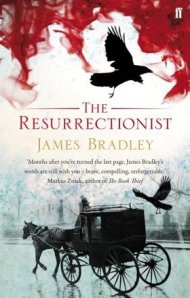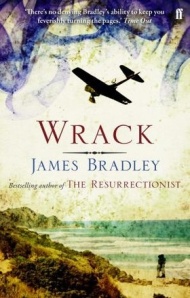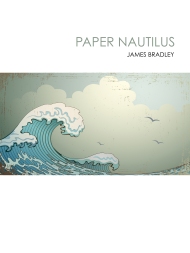Michel Faber, The Book of Strange New Things
 At first blush, science fiction and religion might seem curious bedfellows, the one priding itself on its hard-headedness and rationality, the other giving primacy to faith and the acceptance of mystery.
At first blush, science fiction and religion might seem curious bedfellows, the one priding itself on its hard-headedness and rationality, the other giving primacy to faith and the acceptance of mystery.
But dig a little deeper and the differences are less obvious, and not just because of the tradition of books such as James Blish’s A Case of Conscience and Mary Doria Russell’s The Sparrow that explore questions about religion, but because Christianity’s eschatological underpinning is given literal form in many of science fiction’s most famous images of transcendence. After all, what are the final moments of Kubrick’s 2001, or the uploaded consciousnesses and singularities of the cyberpunks and their inheritors but updated versions of the Rapture?
Yet there’s little doubt there have been few science fiction novels as explicitly concerned with the meaning of faith as Michel Faber’s The Book of Strange New Things, a book that features a missionary despatched to an alien world to preach the Gospel to the natives while what looks suspiciously like the end of days consumes our own.
For the missionary, the aptly named Peter Leigh, the position is an extraordinary opportunity, even if it means being separated from his wife, Bea. Although surprisingly little is understood about the planet – Oasis – or its inhabitants, the aliens have specifically requested a missionary be sent, in order that they might learn more about the teachings of the Bible – or as they know it, The Book of Strange New Things – and more particularly its promises of eternal life.
Yet the task quickly proves more difficult than Peter anticipated. For although many of the Oasans are receptive to what he has to say, he finds himself overwhelmed not just by the strangeness of the planet, its oppressive humidity, altered colours and 72 hour days and nights, but by the problems of communicating his message in a way that treats the Oasans as equals.
The situation is not helped by the fact every other human on the planet is an employee of the company in charge of the colonisation, a faceless transnational called USIC (at one point Peter admits he doesn’t know what the letters stand for and is told it doesn’t really matter, “all the meaningful names have been taken”), and seem to have been selected precisely because they have no desire for meaningful contact with the people around them.
But the real problem is back on Earth, where a string of disasters and economic crises lead a newly pregnant Bea to begin to question first Peter, then their relationship, and finally her faith.
These sections – and indeed Faber’s incredibly tender depiction of Peter and Bea’s relationship more generally – are deeply affecting in their own right. But they’re made even more affecting by the fact the novel was written in the shadow of Faber’s wife Eva Youren’s struggle with cancer (Youren died earlier this year, and Faber has said in interviews The Book of Strange New Things will be his last novel). Indeed in one sense The Book of Strange New Things is perhaps best understood as a study of that most undramatic of things, a happy marriage.
At another level though the novel is engaged with a series of questions about religion and its fantasies of salvation and ending. These fantasies are embodied in the book itself, which in a sort of eschatological grace note takes the title of each of its chapters from the last line of that chapter, reinforcing the suggestion that all actions are, in the end, driving toward a particular conclusion. But this structural device is subverted by the resolutely homely nature of Peter and Bea’s faith, and their determination to do good in this life, not merely as a path to rewards in the next, but because by helping others we make both ourselves and the world a better place.
Simultaneously though there’s more than a whiff of Conrad about Peter’s journey and the colonial ambitions of USIC (despite a lovely bit of misdirection in the afterword it’s difficult to believe Peter’s predecessor, who disappeared after going native, is called Kurtzenberg by accident). Yet despite the allusions to Heart of Darkness (and indeed Robert Silverberg’s Downward to the Earth) the novel’s method is never to derange or unsettle in any direct way. Indeed even the Oasans themselves, whose faces resemble “two foetuses curled up” never seem particularly alien or Other in any meaningful way.
It’s tempting to regard this as a failing, of a piece with the book’s oddly cursory attention to the mechanics of its science fictional bells and whistles. How one wants to ask, was Oasis discovered? Why does there only seem to be one group of Oasans? Aren’t there other communities, other cultures elsewhere on the planet? Why does Earth’s economy and environment collapse so suddenly and completely?
Yet I suspect asking these sorts of questions is to miss the point. Because despite its title The Book of Strange New Things isn’t interested in communicating or capturing strangeness at all, quite the reverse. Instead it seeks to demonstrate how inimical the modern world is to the miraculous, how inured it is against true beauty.
This interest in the deadening effects of contemporary culture is not new in Faber’s writing – indeed it’s front and centre in both his first novel, Under The Skin (to which The Book of Strange New Things seems to nod in its opening chapter’s depiction of Peter and Bea’s journey toward the airport along a series of anonymous motorways and layovers), and his third, The Fire Gospel, which was published as part of Canongate’s Myth Series in 2008. But in The Book of Strange New Things it is woven into the fabric of the book, captured not just in the weird affectlessness of the prose but in the USIC employees’ lack of desire to engage not just with questions of faith, but with questions of any kind. Against this backdrop Peter’s faith, like the simple happiness he shares with Bea, seems quixotic at best, an act of folly. Yet it is the triumph of this deeply strange yet strangely affecting novel that it also seems a kind of grace.
This is an extended version of a review that appeared in The Sydney Morning Herald and The Age on 13 December 2014.








